 Today marks the 193rd anniversary of the discovery of the Venus de Milo on the Aegean island of Melos. In 1820 Melos was under the rule of the Ottoman Turks.
Today marks the 193rd anniversary of the discovery of the Venus de Milo on the Aegean island of Melos. In 1820 Melos was under the rule of the Ottoman Turks.
The famous statue, broken into several pieces, was discovered by a farmer who’d been removing stones from and ancient wall. He showed his discovery to two French ensigns whose ships were in port. One of the ensigns, Jules Dumont d’Urville, later told the Comte de Marcellus, secretary to the Marquis de Rivière, the French ambassador in Constantinople, who convinced the ambassador that he should purchase the statue and present it as a gift to restored King Louis XVIII.
Marcellus traveled to Melos only to discover that the statue had been sold to a provincial pasha but the local officials were convinced that France had the earlier claim. Marcellus paid the officials 250 francs and the farmer, 750. The Turks also fined the officials for not holding the statue for the French, but Rivière reimbursed them in return for a quittance so that the claim on the statue could not be disputed. (Although it later was disputed by the Germans who claimed they owned the land upon which it was discovered. That dispute continued into the twentieth century)
The Venus de Milo arrived in Paris and was presented to the king in March, 1821, although he was too obese to see it and did not see it for another year. Its restoration was under the supervision of the Comte de Forbin who had been named director of the Louvre in 1816. The Venus de Milo became a source of pride for France, a worthy rival to the British Museum’s acquisition of the Elgin Marbles and some compensation for the loss of the Apollo Belvedere and the Venus de’ Medici, both returned to Italy after Napoleon’s defeat.
More controversy ensued as to the age of the statue. Was it a masterpiece of the Classical Age or an example from the later, less prestigious Hellenistic period? The latter won out eventually and the Louvre dates the statue from around 120 BC.
Another dilemma was whether the arms should be restored. All that was discovered of the arms was a fragment of a hand holding an apple. Ultimately Forbin decided not to restore the arms.
 The Comte de Forbin led a rather exciting life. An artist, in the early 1800s he was the lover of Napoleon’s sister, Pauline. When she tired of him, he was sent to war, distinguishing himself in battle
The Comte de Forbin led a rather exciting life. An artist, in the early 1800s he was the lover of Napoleon’s sister, Pauline. When she tired of him, he was sent to war, distinguishing himself in battle
 and winning a Legion of Honor. He also had an affair with Madame Récamier. Both women are immortalized in the Louvre. Pauline in a statue of by Canova; Récamier in a portrait by David.
and winning a Legion of Honor. He also had an affair with Madame Récamier. Both women are immortalized in the Louvre. Pauline in a statue of by Canova; Récamier in a portrait by David.
Jules Dumont d’Urville, one of the ensigns who was originally shown the Venus, rose to become a rear admiral and a renowned French explorer, botanist and cartographer. He explored the Pacific, Australia, New Zealand and Antarctica. He is mentioned by Jules Verne in 20,000 Leagues Under the Sea. Dumont d’Urville and his whole family died in the flames of the Versailles train crash, France’s first railway disaster.
Have you seen the Venus de Milo? What is your favorite statue, ancient or not?

Yes, I have. David is impressive, but I have to admit Winged Victory chokes me up, even in pictures. I don’t know why.
Oh, me, too, Laurel! I long to see it in person.
I have seen it, and many wonderful treasures in the Louvre. But scratching my head over the “too obese to see it” comment. If the statue was presented to Louis, how could he not see it?
Well, I suppose it was formally presented but taken to the museum. Perhaps Louis could not negotiate some stairs or something?
How lucky you’ve been to see all the beautiful things you’ve seen in Europe!!
I have not seen it in person, but hope to, someday. I saw a couple of rooms at the Louvre in 1974, on a high school French Club trip to France! Wonderful memories. One of my favorite statues is Michelangelo’s Pietà. Almost more amazing than the scultpture itself is the fact that he was 24 when he created it. Countless miracles in our world! I’m pasting a jpg of the Pietà below, but don’t know if it will work:
http://upload.wikimedia.org/wikipedia/commons/thumb/1/1f/Michelangelo's_Pieta_5450_cropncleaned_edit.jpg/300px-Michelangelo's_Pieta_5450_cropncleaned_edit.jpg
I have seen the Pieta! It is as beautiful as anyone could hope.